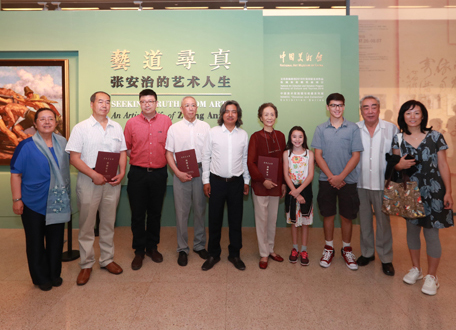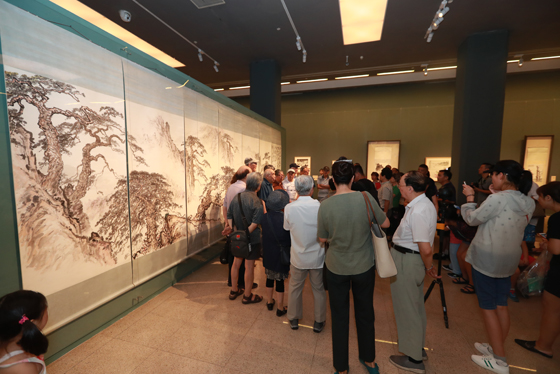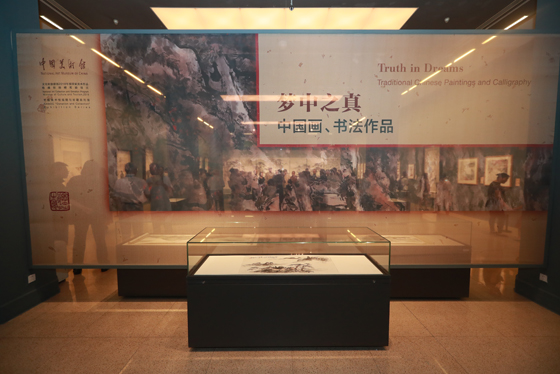Seeking Truth from Arts – An Artistic Life of Zhang Anzhi Kicked Off at NAMOC
Source:: Time:2018年08月02日
On July 26, 2018, the "Seeking Truth from Arts – An Artistic Life of Zhang Anzhi," hosted by the National Art Museum of China (NAMOC) kicked off at NAMOC. The exhibition was “The 2018 National Art Collection and Donation Project of the Ministry of Culture and Tourism” and also the “NAMOC Donation and Collection Exhibition Series”. The exhibition was divided into three chapters: “Dream in the Truth”, “Truth in the Dreams”, “Scholarly Heart”. The 139 pieces of Zhang Anzhi’s works included oil painting, Chinese painting, sketch, pastel, watercolor and calligraphy. On the afternoon of the same day, the "Artistic Life of Zhang Anzhi" symposium was held in NAMOC’s Auditorium.
Zhang Anzhi (1911-1990), a native of Yangzhou, Jiangsu Province, was admitted to the Art Department, College of Education of Central University in 1928. In 1929, he studied in the Western Painting Class where he was taught by Mr. Xu Beihong, Pan Yuliang, and Cai Renda among other teachers. He graduated from the Art Department of the National Central University in Nanjing in 1931. He was an assistant professor at the Central University and an associate researcher at the China Academy of Art in Chongqing. In 1946, he was trained at the University of London's Kota Art Institute. He used to teach the Fine Arts Department of the Nanjing-based National Central University, the China Academy of Art (in Chongqing), the Art Department of the Beijing Normal University, Beijing Art Normal College, the Chinese Painting Department and History of Art Department of Central Academy of Fine Arts, and served as a doctoral tutor at the same time.
Mr. Zhang Anzhi's artistic life was exactly the reflection of the magnificent social reality of the 20th century. The integration of Chinese and Western cultures was the most remarkable feature of the era in which Zhang Anzhi lived. His academic history unfolded under the collision of Chinese and Western cultures and the unity of personal aspiration and reality one by one. In the accumulation of Chinese traditional culture, Mr. Zhang benefited from the influence of the literati of the older generation when he was small. In the home of his grandfather in Nanjing, his uncle She Hengchang, a Xiucai (one who passed the imperial examination at the county level) of the Qing Dynasty often had literati gatherings with Liang Gongyue, Ling Wenyuan and Li Ruiqing. He heard, saw and accepted the tradition. His interest in poetry, painting and calligraphy grew day by day. It can be seen from the flower and bird paintings he learnt to imitate his master Xie Gongzhan, that he had already had a certain foundation in the traditional flower and bird painting techniques. Later he entered the Central University and chose to study in Lv Fengzi and Wang Caibai's Chinese painting class, with which he laid a solid foundation for the understanding and practice of traditional ink and wash painting. He was taught in poetry by Mr. Wang Dong and Mr. Wu Mei. In the aesthetic theory, he was nurtured by Mr. Zong Baihua which laid him the foundation to study the history of art of China. Mr. Zhang’s study of Western culture began with the study of the Western Painting Class of the College of Education of the Central University, where he met with Mr. Xu Beihong, Pan Yuliang and Cai Renda who had just returned from France. It was at this time that he received systematic training of Western painting and became astoundingly skillful in sketching, oil painting, watercolor, and pastel, making himself a western painting talent in early art college education of China. Mr. Zhang went to the United Kingdom for study, training and exchange from 1946 to 1950, and studied art history at the University of London's Kota Art Institute where he began to touch upon ways to study Western art history. His experience in Europe enabled him a deep understanding of Western culture, and the opportunity to re-examine the national characteristics of Chinese culture in a cultural comparison context, and then promoted his exploration of modernity in art creation and the theory of history study.
Zhang Anzhi (1911-1990), a native of Yangzhou, Jiangsu Province, was admitted to the Art Department, College of Education of Central University in 1928. In 1929, he studied in the Western Painting Class where he was taught by Mr. Xu Beihong, Pan Yuliang, and Cai Renda among other teachers. He graduated from the Art Department of the National Central University in Nanjing in 1931. He was an assistant professor at the Central University and an associate researcher at the China Academy of Art in Chongqing. In 1946, he was trained at the University of London's Kota Art Institute. He used to teach the Fine Arts Department of the Nanjing-based National Central University, the China Academy of Art (in Chongqing), the Art Department of the Beijing Normal University, Beijing Art Normal College, the Chinese Painting Department and History of Art Department of Central Academy of Fine Arts, and served as a doctoral tutor at the same time.
Mr. Zhang Anzhi's artistic life was exactly the reflection of the magnificent social reality of the 20th century. The integration of Chinese and Western cultures was the most remarkable feature of the era in which Zhang Anzhi lived. His academic history unfolded under the collision of Chinese and Western cultures and the unity of personal aspiration and reality one by one. In the accumulation of Chinese traditional culture, Mr. Zhang benefited from the influence of the literati of the older generation when he was small. In the home of his grandfather in Nanjing, his uncle She Hengchang, a Xiucai (one who passed the imperial examination at the county level) of the Qing Dynasty often had literati gatherings with Liang Gongyue, Ling Wenyuan and Li Ruiqing. He heard, saw and accepted the tradition. His interest in poetry, painting and calligraphy grew day by day. It can be seen from the flower and bird paintings he learnt to imitate his master Xie Gongzhan, that he had already had a certain foundation in the traditional flower and bird painting techniques. Later he entered the Central University and chose to study in Lv Fengzi and Wang Caibai's Chinese painting class, with which he laid a solid foundation for the understanding and practice of traditional ink and wash painting. He was taught in poetry by Mr. Wang Dong and Mr. Wu Mei. In the aesthetic theory, he was nurtured by Mr. Zong Baihua which laid him the foundation to study the history of art of China. Mr. Zhang’s study of Western culture began with the study of the Western Painting Class of the College of Education of the Central University, where he met with Mr. Xu Beihong, Pan Yuliang and Cai Renda who had just returned from France. It was at this time that he received systematic training of Western painting and became astoundingly skillful in sketching, oil painting, watercolor, and pastel, making himself a western painting talent in early art college education of China. Mr. Zhang went to the United Kingdom for study, training and exchange from 1946 to 1950, and studied art history at the University of London's Kota Art Institute where he began to touch upon ways to study Western art history. His experience in Europe enabled him a deep understanding of Western culture, and the opportunity to re-examine the national characteristics of Chinese culture in a cultural comparison context, and then promoted his exploration of modernity in art creation and the theory of history study.




